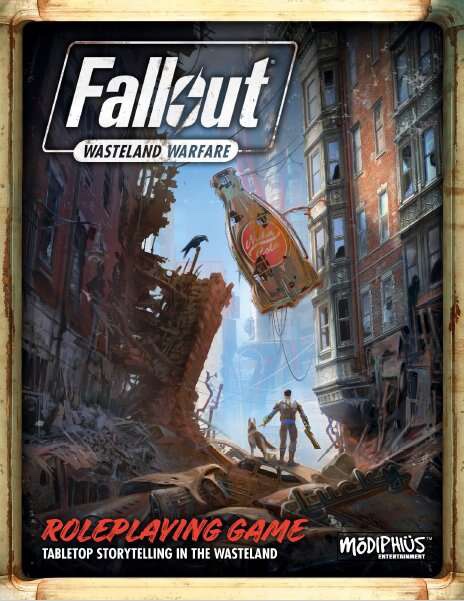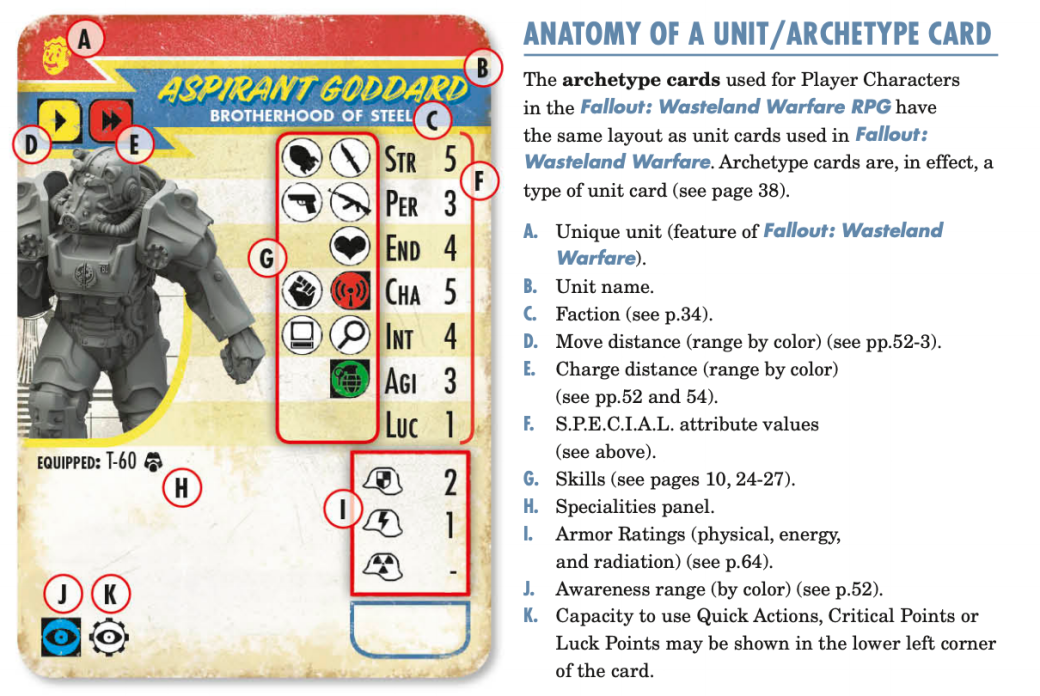Fallout: Wasteland Warfare RPG Expansion – Modiphius

Disclosure: DriveThruRPG links in this article are affiliate links. If you make a purchase after clicking them I receive a small commission at no extra cost to you. This helps support my efforts to bring you reviews of fun and interesting games!
War. War never changes. Neither does the Wasteland. Factions rise and fall, two-headed cows abound, and Vault Dwellers venture forth with the assistance of the all-knowing Pip Boy to guide them in their journey.
This is the roleplaying game expansion to the miniatures wargame Fallout: Wasteland Warfare, which is based on the bestselling and immensely popular series of computer/video games about a post-nuclear United States of America. It’s gritty, it’s grimy, sometimes goofy – it’s the post-apocalyptic future of the 1950s. In this game players guide their heroes through the aftermath of nuclear war, avoiding ghouls, raiders, super mutants, and the threat of radiation. Refereed by The Overseer, who plots out their potential paths and controls the other inhabitants of the world, the Player Characters must rely on their wits and a good sidearm to survive.
If you’re a fan of the miniature wargame Fallout: Wasteland Warfare then there is no reason for you to not like the RPG expansion. If you’re a fan of the Fallout franchise then you’ll get a complete game that allows you to create your own adventures in the Wasteland. This version of the game doesn’t use Modiphius’ 2d20 system (that’s for a future version), instead using the proprietary dice and tactical fury of the miniatures game as the chassis for its rules. This is a well-crafted and tested tactical roleplaying game that, despite its origins, doesn’t actually require miniatures to play – though the excellent sculpts may nonetheless sway you to use them.
The setting gets an overview in the beginning of the book detailing the history, major factions, and some of the creatures one might encounter and be killed by. Sidebar information is presented throughout the book by the iconic Pip Boy, the helpful cartoon character of the Fallout franchise.
Newcomers to the game may find these reference documents helpful:
While these documents are for the miniatures game, they’ll help illustrate certain elements of the RPG as well.
Fallout doesn’t use traditional numbered polyhedral dice. Instead the faces show a mix of numbers and symbols. The Skill Die (a d20) has the numbers 2-10, with icons that generate Action Points (useable for additional quick actions), Critical Points (for powerful weapon effects), and other symbols that indicate a failed test.
Effect Dice (d12s) are added when skills, equipment, luck, and other circumstances would affect the outcome of a roll. They can increase damage, reduce the target’s resistance to damage, increase chances of a successful test, or generate special effects from abilities and gear. The red Effect Die, the “Resistance Die”, reduces impact (how successful you are), making tests more difficult. If you don’t have a set, you can refer to the chart (linked above) for a sense of how the dice faces look.
Character creation is fast and straightforward. Characters are made up of the traditional Fallout S.P.E.C.I.A.L. Attributes. These are Strength, Perception, Endurance, Charisma, Intelligence, Agility, and Luck. They receive a numerical rating to indicate relative power in those areas. They also have Expertise Skills, a standard list of utility and knowledge skills, and separate Combat Skills. Skills are linked to an Attribute which will determine your base target number when making a related test.
Players choose from a list of archetype cards, which pregenerate the basics of a character. The list covers a wide variety of options – most any you’d need in a post-nuclear wasteland. Possible choices include Forager, Bandit, Infantry, Technician, and Researcher. Though the list does lack a “Face” role, Fixer has a high Charisma, so will probably double as your group’s talker. You can also use archetype cards available in the Wasteland Warfare miniatures game and even create your own once you’re comfortable with the system. You’ll actually use a character sheet called a “game mat”, which will help you arrange your items, archetype, and other elements unique to your character.
You then modify the archetype by adding gifts and scars: positive and negative features from the character’s past like Fast Healer, Ally, and Iron Stomach, Dullard, Hunted, and Night Blind. Record your Expertise skills, spend some starting Experience Points on Perks (similar to Gifts), Specialties (areas of focus in Skills that give bonuses to tests), and more skills. Once you’ve gone on a shopping spree you’re done! Welcome to the Wasteland!
What’s especially great about the Archetype cards is how concisely they present necessary information. Icons and colors help communicate elements of the game. Once you memorize the symbols you’ll have an easy shortcut for reference material.

When characters attempt an activity with an uncertain outcome, they roll a skill test. The player rolls a Skill Die, possibly some Effect Dice, and compares the result to the Skill Value (based on the Skill’s linked Attribute). The Archetype card lists common Skills next to the Attribute, using icons for some (see above). If the roll is equal or lower than the Skill Value the test is successful. The magnitude of success is measured in impact. A successful Skill test generates 1 impact and the greater the difficulty, the more impact is needed. Certain symbols on Effect Dice will generate additional impact, allowing a player to meet that difficulty.
Because the outcome of a test can be modified by a number of factors, partial successes are possible, resulting in extended tests to generate enough impact for a successful test.
Opposed tests are determined by both parties rolling a Skill Test and the higher impact wins. Ties are determined by who has the higher roll.
That this is an RPG expansion to a miniatures wargame is very evident in combat (or “Action Play”). It uses terminology familiar to other RPGs, but the examples are presented like a wargame manual and the visuals are pictures of miniatures. It’s exceedingly suitable for this game and I feel replicates the Fallout games back when they had an isometric, birds-eye view perspective.
The combat rules are precise and encompassing, as they should be with their wargame roots. The proprietary dice are in full force, of course, as Effect Dice play a major role in combat – determining damage, reducing Armor, and other features. The Weapon cards are very useful as they display the Special Effects of the weapon, its range categories, the Effect Dice that are rolled when attacking, an icon for the associated skill, how much and what kind of damage it does (physical, energy, or radiation), and any Critical features or special abilities.
Health is based off a character’s Endurance Attribute, so it typically isn’t all that high. It’s pretty clear that having good armor and thinking tactically will help you survive – you don’t have a wealth of hit points that will allow you to wade in guns blazing.
It’s really interesting how the designers use color as an indicator of certain game elements such as with Effect Dice, Movement and Range. The range rulers are also organized by the number of corners and curved edges, and the Effect Dice locate symbols differently from each other, in case a reader has difficulty distinguishing the colors. It’s a helpful consideration for such a visually-intensive game.
Encumbrance plays a role in Fallout: Wasteland Warfare and that makes me happy. I don’t think it should be a key element in every game, but one that revolves around survival in a wasteland requires it. Over-encumbrance simply slows a character down, rather than affects Skill Tests, and I think that’s fine. It’s also easy to not become encumbered and the bookkeeping is straightforward, so players shouldn’t have to worry about these rules being intrusive.
The section for The Overseer (Gamemaster) is well-tailored towards running this specific game as well as running an RPG for new players. Since Fallout uses alternative dice, the advice on modifying Skill Tests and the difference between giving a Skill bonus or penalty versus adding Effect Dice is really useful in understanding how those play a role in the game. Considering the nature of the setting, I also like how there are rules surrounding scavenging, item crafting, and settlements. To me, part of the appeal of a post-apocalyptic setting is in rebuilding society on a familiar, but blank slate, and those three elements are essential to that kind of gameplay.
The last major section of the book is the three-part mini-campaign “Parzival and the Wasteland Knights.” Without getting into spoilers it’s a very good read that presents a number of the trappings and elements of Fallout for players to experience. There are useful sidebars for The Overseer, helping guide them through the campaign and offering advice on stumbling blocks like: “how to be flexible if the players don’t follow the typical heroic path.” It’s also nice that the campaign doesn’t follow a completely set path and different events can occur at different junctures, depending on earlier encounters. As the book lacks an explicit enemies section, the campaign (in conjunction with the archetype cards) doubles as a bestiary. The iconic Fallout enemies receive cards and can be easily tweaked to adjust their power level.
Overall, the Fallout: Wasteland Warfare RPG Expansion presents a tactically interesting roleplaying game with lots of fun design elements, wrapped in the setting of a fabulous franchise. The use of cards and special dice add a nice new element to the game and offer a little something extra.
If you dare to venture from the security of your Vault, check out the game at the Modiphius website or from the Affiliate links below to help support this site!
DriveThruRPG (PDF)
Amazon (Print)